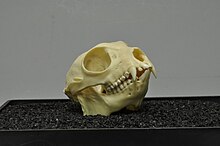Diademed Sifaka
| Diademed Sifaka | ||||||||||||
|---|---|---|---|---|---|---|---|---|---|---|---|---|

Diademed Sifaka ( Propithecus diadema ) |
||||||||||||
| Systematics | ||||||||||||
|
||||||||||||
| Scientific name | ||||||||||||
| Propithecus diadema | ||||||||||||
| Bennett , 1832 |
The Diademed Sifaka ( Propithecus diadema ) is a species of primate from the Indri-like family within the lemurs .
features


Diademed Sifakas are among the most colorful species of lemurs. Their fur is long and silky, and the colors of individual animals can vary considerably. Generally the head is white, on the top of the head there is a black spot that extends to the nape of the neck. The face is hairless and also black, the eyes are red-brown. The shoulders and the upper part of the back are black or dark gray, the back becomes light gray to whitish towards the back, the tail is white. The chest and stomach are also white or light gray. The arms and legs are orange to golden yellow, the hands and feet are black. In the south of the distribution area the animals are sometimes much darker, so the head is dark gray or black except for a white spot on the forehead. It is not yet clear whether this is a subspecies of its own.
Diademed Sifakas reach a head body length of 50 to 55 centimeters, the tail measures 44 to 50 centimeters. The weight of the animals is 5 to 8 kilograms, making them the largest sifakas and the second largest living lemurs after the Indri .
distribution and habitat
Like all lemurs, diademed sifakas live in Madagascar . Their distribution area is on the east coast of the island between the Mananara River in the north and the Mangoro and Onive rivers in the south. Their habitat are tropical rainforests , they occur up to 1700 meters above sea level.
Lifestyle and diet
These primates are diurnal tree dwellers. They move vertically climbing and jumping, but sometimes they come to the ground. They live in groups of up to eight animals, these groups are made up of several males and females as well as the common offspring. Groups inhabit areas of 25 to 60 hectares, which are marked with glandular secretions. The length of the daily forays is around 500 to 1700 meters. The group members communicate with each other with sounds, but sounds are rarely used to indicate the territory. The groups are dominated by the females, often a family of closely related females forms the core of the group.
The diet of the Diademed Sifakas consists of leaves, fruits, seeds and buds; on the ground they eat fallen fruit, mushrooms and sometimes soil.
Reproduction
After a gestation period of around 170 to 180 days, the female usually gives birth to a single young in June. This first clings to the mother's stomach and later rides on her back. The young animals are finally weaned after six months. When reaching sexual maturity, the males have to leave their birth group, the females usually remain in it.
Danger
The main threat to the diademed sifakas is the destruction of their habitat by slash and burn, and in some areas they are also hunted. The IUCN estimates that in the last 30 years (three generations) has decreased the population by more than 50%, and lists the species as "critically endangered" ( endangered ).
The species is no longer kept in Europe, the only holder was London.
Systematics
The diadema sifaka , together with the silk sifaka , the Edwards sifaka and the Perrier sifaka, form the diadema species group within the genus of the sifakas . All of the named species were until recently considered to be its subspecies, but are now classified as independent.
literature
- Nick Garbutt: Mammals of Madagascar. A Complete Guide. Yale University Press, New Haven CT 2007, ISBN 978-0-300-12550-4 .
- Thomas Geissmann : Comparative Primatology. Springer-Verlag, Berlin et al. 2002, ISBN 3-540-43645-6 .
- Russell A. Mittermeier , Jörg U. Ganzhorn, William R. Konstant, Kenneth Glander, Ian Tattersall , Colin P. Groves , Anthony B. Rylands, Andreas Hapke, Jonah Ratsimbazafy, Mireya I. Mayor, Edward Louis jr, Yves Rumpler, Christoph Schwitzer, Rodin Rasoloarison: Lemur Diversity in Madagascar. In: International Journal of Primatology. 29, 2008, ISSN 0164-0291 , pp. 1607-1656.
supporting documents
Web links
- Propithecus diadema onthe IUCN Red List of Threatened Species . Retrieved April 23, 2009.



